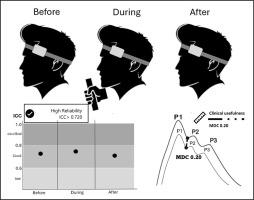无创P2/P1比值的重测信度以及静止和等距握力时的峰值时间
IF 2.3
4区 医学
Q3 ENGINEERING, BIOMEDICAL
引用次数: 0
摘要
目的:本研究旨在确定健康年轻人在静息和生理应激条件下无创P2/P1比值的测试-重测可靠性。方法对58例健康青年(平均年龄23.4±4.0岁)进行颅内脉搏波形分析。该方案包括5分钟的基线,1分钟的最大等长握力和5分钟的恢复期。这一过程分别在三天内重复进行。相对信度采用类内相关系数(ICC)评估,绝对信度采用计量标准误差(SEM)和最小可检测变化(MDC)评估。结果P2/P1比值在基线(ICC = 0.72)、最大等距努力(ICC = 0.74)和恢复(ICC = 0.72)等条件下均表现出良好的重测信度。绝对可靠性很高,测量标准误差很小(SEM≤0.1),最小可检测变化(MDC95)约为0.24。结论无创测量的P2/P1比值在健康年轻人中是一个可靠的指标,即使在严重的心血管压力下也能保持其一致性。本研究还建立了MDC,提供了一个定量阈值来区分真实的生理变化和测量误差。这些发现支持使用P2/P1比值监测脑血管动力学,并为未来临床人群(如危重患者)的研究提供基础数据。本文章由计算机程序翻译,如有差异,请以英文原文为准。

Test-retest reliability of non-invasive P2/P1 ratio and time to peak at rest and during isometric handgrip stress
Purpose
This study aimed to determine the test-retest reliability of the non-invasive P2/P1 ratio, a metric derived from cranial pulsatility waveforms, in healthy young adults under both resting and physiological stress conditions.
Methods
Intracranial pulsatility waveforms were acquired from 58 healthy young adults (mean age 23.4 ± 4.0 years). The protocol involved a 5-minute baseline, 1 min of maximal isometric handgrip effort, and a 5-minute recovery period. This procedure was repeated on three separate days. Relative reliability was evaluated using the Intraclass Correlation Coefficient (ICC), and absolute reliability was assessed with the Standard Error of Measurement (SEM) and the Minimum Detectable Change (MDC).
Results
The P2/P1 ratio demonstrated good test-retest reliability across all conditions: baseline (ICC = 0.72), during maximal isometric effort (ICC = 0.74), and recovery (ICC = 0.72). Absolute reliability was high, with a small Standard Error of Measurement (SEM ≤ 0.1) and a Minimum Detectable Change (MDC95) of approximately 0.24 established during the effort.
Conclusion
The non-invasively measured P2/P1 ratio is a reliable metric in healthy young adults, maintaining its consistency even during significant cardiovascular stress. This study also establishes the MDC, providing a quantitative threshold to distinguish true physiological changes from measurement error. These findings support the use of the P2/P1 ratio for monitoring cerebrovascular dynamics and provide foundational data for future studies in clinical populations, such as critically ill patients.
求助全文
通过发布文献求助,成功后即可免费获取论文全文。
去求助
来源期刊

Medical Engineering & Physics
工程技术-工程:生物医学
CiteScore
4.30
自引率
4.50%
发文量
172
审稿时长
3.0 months
期刊介绍:
Medical Engineering & Physics provides a forum for the publication of the latest developments in biomedical engineering, and reflects the essential multidisciplinary nature of the subject. The journal publishes in-depth critical reviews, scientific papers and technical notes. Our focus encompasses the application of the basic principles of physics and engineering to the development of medical devices and technology, with the ultimate aim of producing improvements in the quality of health care.Topics covered include biomechanics, biomaterials, mechanobiology, rehabilitation engineering, biomedical signal processing and medical device development. Medical Engineering & Physics aims to keep both engineers and clinicians abreast of the latest applications of technology to health care.
 求助内容:
求助内容: 应助结果提醒方式:
应助结果提醒方式:


